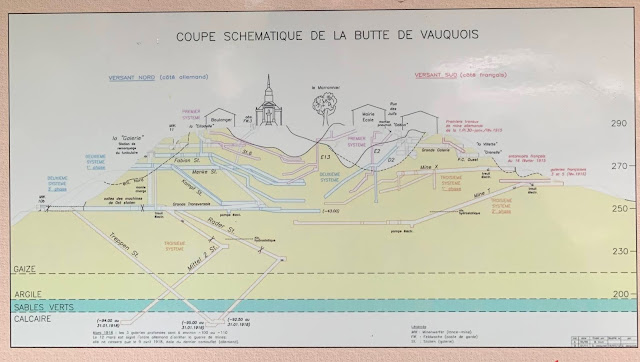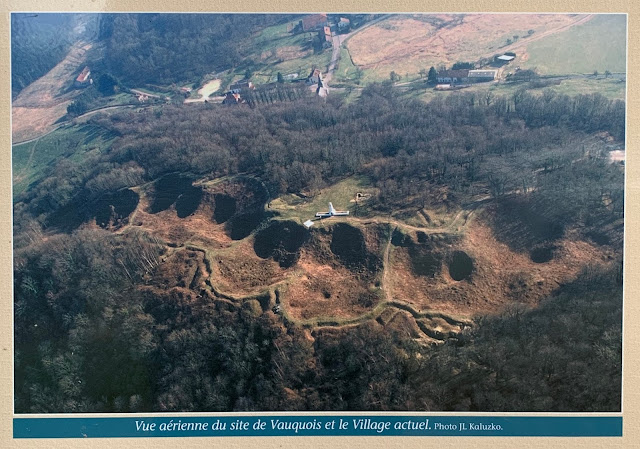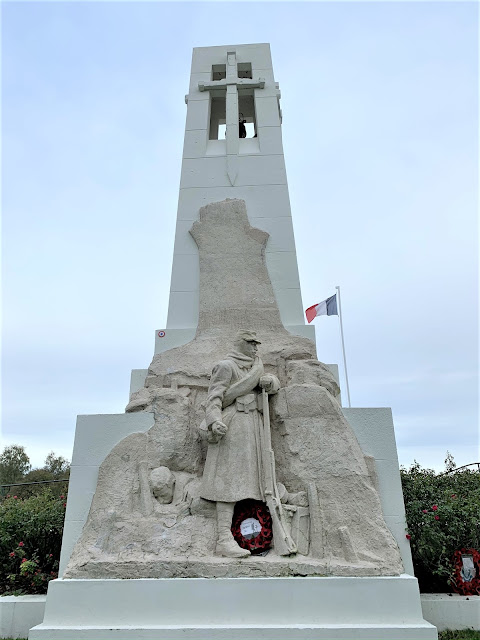Our tour of the Great War continues.
Near Verdun, we visited Vauquois Hill, the site of one of the many battles of the long-running Battle of Verdun. A small village was previously located on top of the hill.
 |
| A view of the hilltop town before The Great War |
Unfortunately, the hill provided long range views in all directions and therefore became a military objective of the rival German and French armies.

At one point, the front line ran across the hill. The town was destroyed during the fighting. You can learn more about the battle for Vauquois Hill below.
We climbed to the top of the hill and found an otherworldly terrain. Where the town once stood were many craters. Each crater resulted from high explosives being detonated underground after being placed there by miners who dug a deep tunnel. The goal was to cause a large explosion underneath an enemy position and then attack them to gain ground. Both sides used that same tactic. In fact, each side would listen for enemy miners, then tunnel underneath where the foes were digging, and finally, ignite explosives to destroy the enemy's tunnel and kill their miners.
Based on what we saw, the mines were successful in destroying the town and killing enemy miners. However, the mines did not seem very effective in moving the front line one direction or the other, since many mines were exploded under the hill over a long period, without significant movement of the battlefront.
Below is a photo of one very large crater. It is hard to appreciate the depth and breadth of the crater, particularly now that grass and trees have grown over the ash and mud. It is very wide and deep. The explosion must have been horrible.

A map below depicts the buildings and street of the former town and the location of the mines exploded under the hill. There is no visible evidence that a town was ever located there.
Below is a photograph showing several mine craters at the top of the hill.
An aerial photo provides a better image of the devastation.
On top of Vauquois Hill is a memorial.
On the hill, we saw barbed wire and iron spikes that were used to defend each side's trenches.
On the side of Vauquios Hill, we saw entrances to the tunnels that ran deep under the hill. Below are photos of one of the tunnels with track laid to carry dirt out and to carry supplies and explosives into the tunnel.
Below, Mike and Marie-Chantal stand at the entrance of another tunnel that ran under the hill.
Here are some of the German and French miners at work.
After visiting Vauquois Hill, we drove to a nearby site of the Great War. The site, a small clearing in the woods with a cemetery, was once the site of the town of Cumières. During the Battle of Verdun, Cumières and other towns in the area were destroyed by artillery. Most of the destroyed towns were not rebuilt after the war, although some civilians who survived the war returned and established new villages nearby. You can learn more about Cumières below.
Below is a photo of what is located today on the site Cumières, a cemetery and monument. The cemetery is mostly empty and we suspect it was rebuilt after the war.
Cumières and other destroyed villages were not rebuilt following the war because of the many unexploded shells in the ground. It was safer and easier to rebuild elsewhere, outside the "Red Zone". The danger still exists. Many areas are fenced or marked to keep out people in case a shell is disturbed or explodes on its own. Because some of the shells contain poisonous gas, the danger is especially serious. Even now, 100 years later, unexploded shells are still recovered in farm fields and elsewhere and then defused by the French army.
The Red Zone is protected for another reason. Digging in the ground can reveal human remains of combatants. So, the Red Zone is protected for the sake of the living and the dead. Human remains that are discovered are exhumed and reinterred in one of the many cemeteries in the region.
Near Cumières, we visited a hill that overlooked the surrounding towns, Le Mort-Homme, or "Dead Man's Hill". Atop the hill is a memorial honoring a French infantry division: a skeletal figure standing tall, with the phrase, "Ils n'ont pas passe", or "they did not get past here".
 |
| "They didn't get past here." |
Le Mort-Homme is located in the Red Zone. It is scarred with countless craters from exploded artillery shells. Visitors must stay in the safe areas.
While visiting Cumières, we learned about aviation during the Battle of Verdun.
Also near Cumières, we discovered a set of recreated trenches (pictured below).
Next Up: The Battle of Verdun continues.






























No comments:
Post a Comment